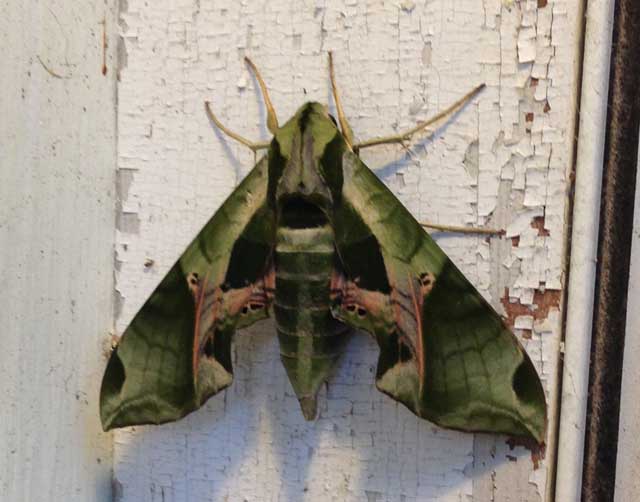Sphinginae subfamily
Sphingini tribe:
 |
Agrius cingulata,
WO Pink-spotted Hawkmoth: Strong migrant; adults nectar from deep-throated flowers including moonflower (Calonyction aculeatum),
morning glory (Convolvulus), honey suckle (Lonicera), petunia.
|
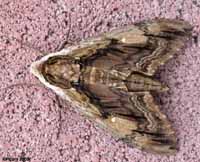 |
Ceratomia amyntor
WO,
Elm Sphinx; Four-horned Sphinx:
Fw upperside: brown with dark brown and white markings including white costal area near wing base, dark streaks along veins,
white spot in cell.
Elm (Ulmus), birch (Betula), basswood (Tilia),
cherry (Prunus). |
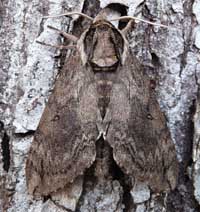 |
Ceratomia catalpae
WO,
Catalpa Sphinx:
The upperside of the forewing is yellowish brown with no white markings, but there are indistinct black lines and dashes. The cell spot is gray with a black outline. The larvae feed in large groups and are much more
spectacular than the moths.
Catalpa is the larval host. |
 |
Ceratomia hageni
WO,
Hagen's Sphinx or Osage Orange Sphinx
The upperside of the forewing is gray with a green tint and has dark
indistinct wavy lines, and pale gray patches at the wing tip and
along the costa. |
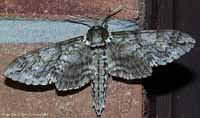 |
Ceratomia undulosa WOMS, Waved Sphinx:
Fw upperside: pale brownish gray with wavy black and white lines and black-outlined white cell spot. Hw upperside: gray with diffuse darker bands.
|
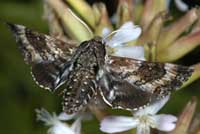 |
Dolba hyloeus WO, Pawpaw Sphinx: The upperside of the forewing is dark brown with a dusting of white
scales. Some moths have patches of reddish or yellowish brown on the wings.
|
 |
Manduca jasminearum WO Ash Sphinx:
Fw upperside: gray to grayish brown with black line running from middle of costa to middle of outer margin; line
may be broken near margin. Splash of brown around cell spot. Hw upperside: mostly black, with gray at lower margin.
|
 |
Manduca quinquemaculatus
WO,
the Five-spotted Hawkmoth:
I suspect if you grow tomatoes, you are likely to encounter Manduca quinquemaculatus.
|
 |
Manduca rustica BS, Rustic Sphinx: Look for three large yellow spots
on each side of the abdomen. Fw upperside: yellowish brown to deep chocolate brown with heavy dusting of white
scales, zigzagged black and white lines.
|
Manduca rustica, August 29, 2013, Bridget Shinn.
 |
Manduca sexta WO, Carolina Sphinx:
If you grow tomatoes, you have probably encountered Manduca sexta
in the larval stage. Larvae get very large and can strip a tomato plant.
|
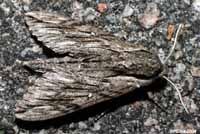 |
Paratrea plebeja
WO, Plebeian Sphinx:
The upperside of the forewing is gray with indistinct black and
white markings. There is a series of black dashes
from the base to the tip, and a small white cell spot.
|
 |
Sphinx chersis WO, Northern Ash Sphinx, Great Ash Sphinx:
Larval hosts are ash, lilac, privet, cherry, and quaking aspen.
|
 |
Sphinx drupiferarum
WO, Wild Cherry
Sphinx: Forewing: dull slate grey with considerable light grey scaling in broad band along costa about 3/4 of distance from body toward apex. Median
lines: black, thin. Wavy, diffuse dark subterminal line, inwardly bordered by white, and whitish bar in terminal area, paralleling outer margin.
|
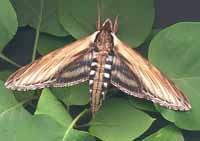 |
Sphinx kalmiae
WO, Laurel Sphinx:
The lower forewings are predominantly brownish-yellow with a fairly wide dark bar along the
inner margin. At rest the wings hug the body, giving the moth a long slender look.
|
Smerinthini Tribe:
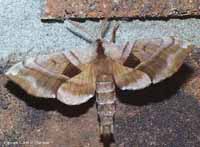 |
Amorpha juglandis
WO, Walnut Sphinx: Highly variable; wings
may be all one color or may have several colors, ranging from pale to
dark brown, may have white or pink tinge. Patterns range from
faint to pronounced.
Female is different. |
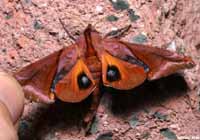 |
Paonias astylus
WO, Huckleberry Sphinx:
Generally, Paonias astylus, (wingspan 55-65 mm),
ranges from Maine south to Florida, west to Missouri and Mississippi. |
 |
Paonias excaecata
WO,
Blinded Sphinx:
Named for dull grey-blue spot (minus dark pupil) in hindwing,
Wide distribution in the eastern United States.
I regularly see them on Prince Edward Island, and they are reported
as far south as Florida. |
 |
Paonias myops BAMONA, Small-eyed Sphinx: Named for the small eye-spot in hindwing;
wide distribution, probably found in many Arkansas counties.
I regularly see them on Prince Edward Island, and they are reported
as far south as Florida.
|
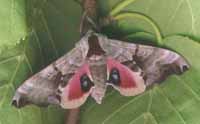 |
Smerinthus jamaicensis WO,
Twin-spotted Sphinx: Widely distributed and fairly common.
Along the East Coast, it flies from P.E.I. to Florida. |
Macroglossinae subfamily
Dilophonotini tribe:
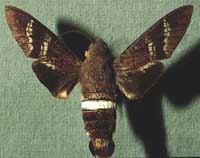 |
Aellopos fadus
WO, Titan Sphinx:
Body: dark brown with wide white stripe across abdomen.
Wings: dark brown. Split in outer white band of forewing
unlikely stray |
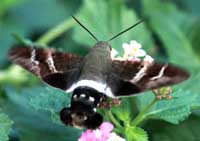 |
Aellopos titan
WO, Titan Sphinx:
Body: dark brown with wide white stripe across abdomen.
Wings: dark brown. Very similar to above species, but the
upperside of the hindwing has
pale patches along the costa and inner margin. unlikely stray |
See Hemaris comparison to help distinguish
the next two species.
 |
Hemaris thysbe WO, Hummingbird Clearwing:
Easy to see why many gardeners would mistake for small hummingbird as it hovers, sipping nectar from flowers through
long feeding tube.
|
 |
Hemaris diffinis
WO,
Snowberry Clearwing:
Adults mimic bumblebees; quite variable. Wings: basically clear, with dark brown to
brownish-orange veins, bases, edges. Thorax: golden-brown to
dark greenish-brown. Abdomen: dark (black) with 1-2
yellow segments.
|
Philampelini tribe:
 |
Eumorpha achemon
WO,
Achemon Sphinx:
Larvae get large and feed on grape vines and Virginia creeper.
Note the differences between this moth and the Pandorus Sphinx. |

|
Eumorpha fasciatus
WO, Banded Sphinx:
Dark pinkish brown with lighter brown band along costa, sharp pinkish white bands and
streaks. Primrose-willow, Ludwigia (water primrose),
other plants in evening primrose family.
|
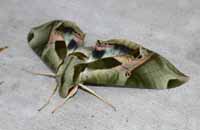 |
Eumorpha pandorus
WO/SH, Pandorus Sphinx:
If you have Grape or Virginia Creeper nearby, then you probably have
this species. I often get asked to identify larvae from areas not
previously reported. |
Eumorpha pandorus, Little Rock, August 26, 2014, Shea Halbert.
Macroglossini tribe:
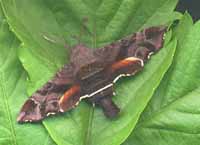 |
Amphion floridensis BAMONA, Nessus Sphinix:
This day flier is widely distributed. If you have Virginia Creeper, you
probably have the Nessus Sphinx. Two bright, distinct, narrow yellow
bands are often visible on the abdomen.
|
 |
Darapsa choerilus
MS, Azalea Sphinx:
The lower wings of this hawkmoth are a solid brownish-orange,
matching the body colour.
You will often see this species listed as Darapsa pholus,
especially in older literature. |
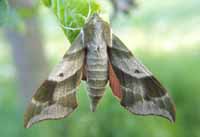 |
Darapsa myron BAMONA, Virginia Creeper Sphinx, Grapevine Sphinx:
If you have foodplants indicated in common names, you probably have this
myron. Hws: orange. |
 |
Darapsa versicolor WO, Hydrangea Sphinx:
If you have hydrangea growing near a stream, then you might have Hydrangea Sphinx. rare
|
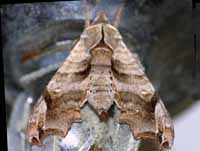 |
Deidamia inscriptum WO, Lettered Sphinx:
Fw outer margin: deeply scalloped.
Light brown with dark brown markings.
There is small black and white spot near tip.
Grape (Vitis), ampelopsis (Ampelopsis), Virginia creeper
(Parthenocissus). |
 |
Hyles lineata
WO, the White-lined Sphinx:
This species has strong migrating tendancies from much further south.
|
 |
Proserpinus guarae WO, Proud Sphinx:
Abdomen may have pale band. Wings: brown. Fw sometimes has greenish tint, may have median area darker.
Lines bordering median area curved. Hw: reddish brown border. possibility
|
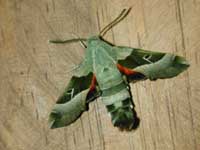 |
Proserpinus juanita WO, Juanita Sphinx:
Fw upperside: pale gray-green with deep green-brown median area and white dash at wing tip.
rare
|
 |
Sphecodina abbottii
MS,
Abbott's Sphinx:
Very much under reported across the United States. It
is a rapid day flier so is probably not in too many collections.
Grape is a popular larval host.
|
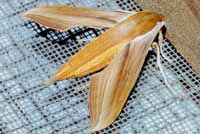 |
The upperside of the forewing is pale brown with lavender-gray at
the base and has dark brown lengthwise lines throughout.
|
|
|


